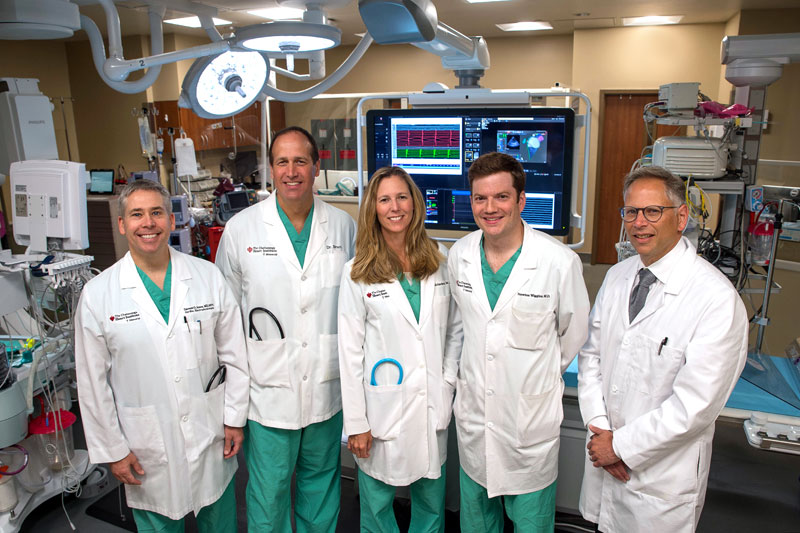Heart Rhythm Center

The dedicated electrophysiologists at The Chattanooga Heart Institute’s Heart Rhythm Center care for all of your heart rhythm needs from routine rhythm monitoring to complex procedures. Electrophysiologists are specialized cardiologists who have advanced training in studying heart rhythm and the electrical pathways of the heart. They treat conditions such as atrial fibrillation and irregular heart rhythms including tachycardia and bradycardia. The electrophysiologists at The Chattanooga Heart Institute work as a team with our cardiologists that specialize in intervention and imaging to ensure patients are receiving the highest level of specialized care.
The heart’s pumping action – or heartbeat – is directed by a complicated electrical system. Millions of people experience irregular or abnormal heartbeats, called arrhythmias, at some point in their life. Most are harmless but some abnormal heart rhythms can be serious and even deadly.
Problems with fast or slow rhythms can be caused by various reasons including a heart attack or aging. People with rhythm problems may experience no systems but many patients tell us they feel that their heart is racing or skipping. Others describe a heart murmur, a flip-flopping sensation, a pounding or a feeling of butterflies. Some experience weakness, shortness of breath and passing out (syncope).
Electrical Disorders
(Source: Heart Rhythm Society 2019)
Arrhythmias that start in the heart’s upper chambers, the atria, include:
Atrial Fibrillation (AF or AFib)
More than 2 million people in the U.S. have atrial fibrillation. In AFib, the heartbeat is irregular and rapid due to disorganized signals from the heart’s electrical system. The upper chambers of the heart may beat as often as 300 – 400 times a minute, about four times faster than normal. Though AFib isn’t life threatening, it can lead to other rhythm problems, feeling tired all the time, and heart failure (with symptoms such as filling up with fluid, swelling of the hands, legs and feet, and shortness of breath). People with AFib are five times more likely to have a stroke than people without the condition. Doctors often prescribe blood thinners (anticoagulants) to patients with AFib to reduce this higher risk of stroke. Click here for more information.
Atrial Flutter (AFL)
Atrial flutter is similar to AFib because it also causes a fast beat in the atria. However, AFL is caused by a single electrical wave that circulates very rapidly in the atrium, about 300 times a minute. This leads to a very fast, but steady, heartbeat. It can also increase the risk of a stroke.
Sick Sinus Syndrome (SSS)
Sick sinus syndrome is not a disease, but a group of signs or symptoms that show that the heart’s natural electrical pacemaker, the sinus node, is not working properly. In SSS, the heart rate can alternate between slow (bradycardia) and fast (tachycardia), often in combination with atrial fibrillation or atrial flutter. Treatment of SSS usually involves implanting a pacemaker, often along with medication.
Sinus Tachycardia
A harmless faster rhythm, sinus tachycardia is a normal increase in heart rate that happens with fever, excitement, and exercise. There is no need for treatment, except in cases when it is caused by an underlying problem, such as anemia (a low blood count) or hyperthyroidism (overactive thyroid gland), or rarely, happens frequently and without a clear cause.
Bradycardia
Bradycardia is a heart rate that’s too slow. What’s considered too slow can depend on age and physical condition. Elderly people are more prone to bradycardia. Causes include problems with the sinoatrial node, problems in the conduction pathways of the heart that don’t allow electrical impulses to pass property from the atria to the ventricles, metabolic problems such as hypothyroidism, damage to the heart from heart disease or heart attack and certain heart medications that can cause bradycardia as a side effect.
Arrhythmias that occur in the heart’s lower chambers, the ventricles, include:
Ventricular Tachycardia (VT)
A life-threatening arrhythmia, ventricular tachycardia is usually seen along with other serious heart disease but sometimes happens in people with normal hearts. Because VT can lead to ventricular fibrillation (a dangerously fast and disorganized heartbeat), it is a serious condition that needs aggressive treatment and follow up.
Treatment options include surgery, radiofrequency ablation (scarring or burning the area of heart tissue that triggers the abnormal rhythm), and/or medication. People with VT are often protected by a defibrillator (a device that can shock the heart out of the dangerous heartbeat) that is implanted in the body.
Ventricular Fibrillation (VF)
Sudden Cardiac Arrest (SCA) caused by ventricular fibrillation is the cause of half of all heart related deaths. In VF, the heartbeat is fast and chaotic, causing the lower heart chambers, or ventricles, to spasm. Sometimes, a heart attack (blockage of the heart pipes/arteries) can lead to VF. VF is sudden, happens without warning, and stops the heart from working. The lack of oxygen to the body, especially to the brain, is deadly. SCA is caused by an electrical problem and although it can be triggered by a heart attack (myocardial infarction), a circulatory (plumbing) problem caused by clogged blood vessels that cut off the supply of blood to the heart, it is not the same as a heart attack. Though CPR may help, the only truly effective VF treatment is defibrillation, which uses paddles or electrodes to “shock” the heart back to normal rhythm. Without treatment, a person with VF will pass out suddenly and die.
Click here for more information on heart rhythm disorders and treatment.



